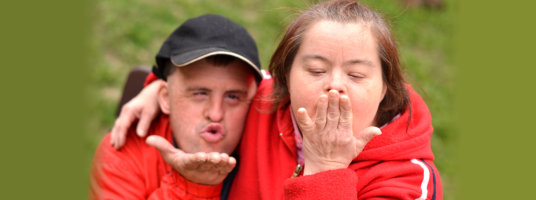
Many of the individuals with developmental disabilities may be the victims of abuse, neglect, or exploitation at some point during their lives. Since many of them are non-verbal and often have significant physical impairments. According to Federal Regulations, these individuals has the right to be free from verbal, sexual, physical, and mental abuse, corporal punishment, and involuntary seclusion and must not be subjected to abuse by anyone, including, but not limited to facility staff, other residents, consultants, volunteers, staff or other agencies serving the resident, family members, legal guardians, friends, and other individuals.
Therefore, as you interact with someone with a developmental disability, you should pay close attention to any changes in how that person looks or acts. A sudden or gradual change in appearance or behavior can be an indicator that abuse, or neglect has occurred or may still be happening.
Maltreatment of people with disabilities takes many forms. It can explode in a moment of abuse, exploitation or it can fester through decades of neglect.
Abuse:
The willful infliction of injury, unreasonable confinement, intimidation, or punishment with resulting physical harm, pain or mental anguish. Abuse can be mental, physical, sexual, or verbal.
Physical abuse:
The use of physical force that may result in bodily injury, physical pain, or impairment.
Examples of physical abuse
Physical abuse may include but is not limited to such acts of violence as:
- striking
- hitting
- beating
- pushing
- shoving
- shaking
- slapping
- kicking
- pinching
- burning.
In addition, inappropriate use of drugs and physical restraints, force feeding, and physical punishment of any kind are all examples of physical abuse.
Signs and Symptoms:
- Bruises, black eyes, welts, lacerations, and rope marks
- Bone fractures, broken bones, and skull fractures;
- Open wounds, cuts, punctures, untreated injuries in various stages of healing;
- Sprains, dislocations, and internal injuries/bleeding;
- Broken eyeglasses/frames, physical signs of being subjected to punishment, and signs of being restrained;
- An individual’s report of being hit, slapped, kicked, or mistreated;
- An individual’s sudden change in behavior;
- The caregiver’s refusal to allow visitors to see an individual alone; or
- Burns.
Sexual abuse:
Non-consensual sexual contact of any kind with a person with a sexual intent that would constitute an offense committed by the person’s caretaker, family member, or other individual who has an ongoing relationship with the person.
Examples of sexual abuse
Sexual abuse may include but is not limited to Non-consensual sexual acts such as:
- Hugging
- Kissing
- Rape
- Sodomy
- Coerced nudity
- Sexually explicit photographing
- Stroking
- Fondling
- Indecent exposure
Sexual contact with any person incapable of giving consent is also considered sexual abuse.
Signs and Symptoms:
- Bruises around the breasts or genital area;
- Unexplained venereal disease or genital infection;
- Unexplained vaginal or anal bleeding;
- Torn, stained, or bloody underclothing; and
- An individual’s report of being sexually assaulted or raped.
Verbal/emotional abuse:
Any use of verbal communication or other behavior to humiliate, intimidate, vilify, degrade, or threaten with harm.
Verbal/Emotional abuse includes but is not limited to:
- verbal assaults
- insults,
- Threats
- Intimidation
- Humiliation
- harassment.
In addition, isolating the individual, giving the individual the silent treatment, and enforced social isolation are examples of verbal/emotional abuse.
Signs and Symptoms:
- Being emotionally upset or agitated;
- Being extremely withdrawn and non-communicative or non-responsive;
- Unusual behavior usually attributed to dementia; or
- An individual’s report of being verbally or emotionally mistreated
Neglect:
A negligent act or omission by any individual responsible for providing care, including medical services that are necessary to avoid physical or emotional harm, pain, or mental illness.
Neglect includes failure of those responsible to provide life necessities such as:
- food,
- water,
- clothing,
- shelter,
- personal hygiene,
- medicine,
- comfort,
- personal safety,
- other essentials.
Signs and Symptoms:
- Dehydration, malnutrition, untreated bed sores, and poor personal hygiene;
- Unattended or untreated health problems;
- Unsanitary conditions (dirty, lice on the person, soiled bedding, fecal/urine smell); and
- An individual’s report of being neglected.
Exploitation:
The illegal or improper use of an individual’s funds, property, or assets.
Examples of exploitation include, but are not limited to:
- Cashing an individual’s with developmental disability’s checks without authorization or permission;
- Forging an individual’s with developmental disability’s signature;
- Misusing or stealing an individual’s with developmental disability’s money or possessions;
- Coercing or deceiving an individual with developmental disability into signing any document (e.g., contracts or will);
- The improper use of conservatorship, guardianship, or power of attorney.
Signs and Symptoms:
- Abrupt changes in a will or other financial documents;
- Unexplained disappearance of funds or valuable possessions;
- Discovery of an individual’s signature being forged for financial transactions or for the titles of his/her possessions; and
- An individual’s report of financial exploitation.
How to Report Abuse, Neglect, and Exploitation (ANE)
The law requires any person who believes that an individual with developmental disability is being abused, neglected, or exploited to report the circumstances to the Texas Department of Family and Protective Services (DFPS) Abuse Hotline.
There are two options for reporting abuse, neglect and exploitation to the Texas Department of Family and Protective Services.
By Phone:
Call the toll-free 1-800-252-5400 Abuse Hotline, 24 hours a day, 7 days a week,
By Secure Internet Website:
From your internet browser, go to https://www.txabusehotline.org.
For life threatening or emergency situations, call 911 immediately, and then make a report to DFPS.
What happens after a complaint have been file?
The name of the person filing the complaint and that of the other person are kept confidential; unless required to be released by law. However, if the complaint is made anonymous, the person who made the complaint won’t be able to know about the results of the investigation.
What’s next?
Within an hour of receiving complaint, DFPS will be notify the following.
- DFPS completes investigation within 14 calendar days.
- Within 5 calendar days, the administrator will notify the individual or legally authorized representative of the finding.
- The individual will be informed on how to request an appeal of the finding.
Resources:
National Center of Elder Abuse Administration on Aging. Types of Abuse.
https://ncea.acl.gov/faq/abusetypes.html#sexual
Oxford Journals. The prevalence of elder abuse and neglect: a systematic review.
https://ageing.oxfordjournals.org/content/37/2/151.long
World Health Organization (WHO). Chapter 5: Abuse of the elderly.
https://www.who.int/violence_injury_prevention/violence/global_campaign/en/chap5.pdf
Code of Federal Regulations (2016). Retrieved from https://www.ecfr.gov/cgi-bin/ECFR?page=browse5
Texas Administrative Code, Title 40, Part 1, Chapter 19, Subchapter B, Rule §19.101 Definitions.
We sincerely appreciate your interest in this important Topic and hope you will join us with your comments.







Leave a Reply